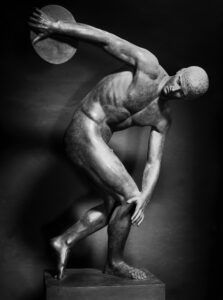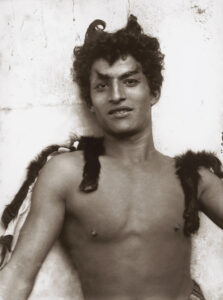From 23 September 2023 to 14 February 2024, the Museo Novecento, in Florence, pays homage to one of the greatest exponents of photography from the last century, Robert Mapplethorpe (New York, 4 November 1946 – Boston, 9 March 1989), in an unprecedented comparison with the shots by Wilhelm von Gloeden and with some thematic works by the Alinari Brothers. Forty years after the great exhibition in 1983 at Palazzo delle Cento Finestre, which made Mapplethorpe’s work known in Florence, the images of the famous New York photographer can be admired again with a project organized in collaboration with the Robert Mapplethorpe Foundation and the Alinari Foundation for Photography which provided the loan of most of the works for this project.

Fratelli Alinari, 1920-1930, Ricostruzione in bronzo del Discobolo della regina Elena, Museo Nazionale Romano, Terme di Diocleziano, Roma, IV sec. a.C. Credito fotografico: Archivi Alinari, Firenze. Collezione: Archivi Alinari-archivio Alinari, Firenze
The exhibition – curated by Sergio Risaliti, director of Museo Novecento, together with Eva Francioli and Muriel Prandato – is the second major event that the museum has dedicated to photography, a practice that revolutionized the art history starting from the second half of the Nineteenth century. Housed in the exhibition spaces on the first and second floors of Museo Novecento, Beauty and Desire draws inspiration from a nucleus of around fifty works that highlights Mapplethorpe’s intense artistic production. In these works the link of his research with classical statuary is underlined, as well as his sculptural approach to the photographic medium, made evident both in the study of the male and female nude, and in the still life, precisely when bodies are equated with objects according to a vision and a sensitivity to detail and material surface that had already been implemented by Edward Weston. Starting from this focus, Robert Mapplethorpe’s work is compared with some photographs dating back to the late nineteenth and early twentieth centuries, coming from the Alinari Archives. Among these, some images of Baron Wilhelm von Gloeden (Wismar, 1856 – Taormina, 1931), among the pioneers of staged photography and a point of reference for some of Mapplethorpe’s photographs, take on special importance. One of the distinctive features of the atmospheres that animate von Gloeden’s compositions is precisely the reference to the past, conceived as an inexhaustible pool of subjects and suggestions: a unique stylistic sign, which still makes him an icon today.

Wilhelm von Gloeden, dalla serie Grande Fauno, Carmelo travestito da fauno, 1890-1899. Credito fotografico: Archivi Alinari, Firenze. Collezione: Archivi Alinari-archivio von Gloeden, Firenze
The interest in the ancient and the passion for the photographers who preceded him are a constant in the Robert Mapplethorpe’s work, who was a passionate and curious collector of photographs. It should be added that Mapplethorpe travelled to Italy at the beginning of the 1980s, where he had the opportunity to directly deal with the landscape of Naples and the disarming power of the historical ruins which in the eyes of the photographer canceled the distance between the present and the past, in a perspective that can in fact be considered post-modern. It was in Naples that Mapplethorpe became acquainted with Baron Guglielmo’s photographs for the first time, thanks to Lucio Amelio, the famous gallery owner, linked to artists such as Joseph Beuys, Andy Warhol, Gilbert & George, Vito Acconci, who was an appreciated connoisseur of the German photographer and collector, and to whom he dedicated an exhibition and two publications between 1977 and 1978, with prefaces by Marina Miraglia and Roland Barthes. It was in Lucio Amelio’s Modern Art Agency that Mapplethorpe exhibited in 1984, proposing an autonomous approach to photography, and an intense combination of formal elements and transversal subjective contents, free from any conformism, in which the continuous metamorphoses between Apollonian spirit and Dionysian sensuality, between the figurative archetypes of the classical world and the iconography of the Catholic world, with precise inspirations drawn from the city of Naples. Furthermore, Lucio Amelio himself was a supporter of the great Mapplethorpe exhibition at the Fortuny in Venice (editorial project of Idea Books), in 1982. But beyond the formal connections, these exhibitions marked and highlighted a homosexual world that declared itself. Perhaps this can be considered non-politically correct information, but it does not detract from the aesthetic product, it simply explains it, motivates it, just as dividing the works by subject does not shed light on Mapplethorpe’s message which he saw in the juxtaposition of incongruous materials (the naked body with the cut flower) the strengthening of the aesthetic message.

Robert Mapplethorpe, Charles Bowman, 1980 copyright © Robert Mapplethorpe Foundation. Courtesy Robert Mapplethorpe Foundation. Used by permission
Beauty and eros are values that are always present in his photographs and must also be found in detail, as well as the presence of death, of the disappearance of youth, so much so that we can speak of his work as a persistent sensuality and a song raised to life. The works on display, while drawing inspiration from the canons of classicism, in fact seem to lead us along unavoidable and at times disturbing aesthetic trajectories, raising and resolving questions on the theme of the body and sexuality whose echo resonates, at times unchanged, in contemporary visual culture, where censorship and moral judgment are always ready to accuse beauty and desire. But Robert Mapplethorpe’s artistic greatness lies precisely in this ability to suppress any false moralism, forcing us to make a frontal, iconic observation of the bodies and sexes exhibited as objects, and at the same time transfiguring these ‘objects’ into pure forms, with a game of strong and plastic black and white, of postures and shots, which refer to a precise study of ancient models.

Robert Mapplethorpe, Antinous, 1987 copyright © Robert Mapplethorpe Foundation. Courtesy Robert Mapplethorpe Foundation. Used by permission
Looking at his photos means recognizing a double life to the photographic image: that of being a mirror of reality – on which its prevaricating and disturbing power depends – and that of being an archetypal form that returns from the past, a returnee, on which it depends its resonance, its shadowy metaphysical radiation. By transforming each of his subjects (a body, a face, a skull, a flower) into a pure form of art from which every possible moral judgment is removed, this author has managed to gain the status of an artwork for his photographs, so much so that even Germano Celant took an interest in his artistic research.
Bruno Sain
Info:
Mapplethorpe / von Gloeden, Beauty and Desire
23.09.2023 – 14.02.2024
Museo Novecento – Firenze
Museonovecento.it

is a contemporary art magazine since 1980






NO COMMENT